
We are reader-supported and may earn a commission on purchases made through links in this article.
Driving through miles and miles of woods without a town in sight, we realized Adirondack Park is big. And it is officially called Adirondack Park. The word “State” is not in its name. The park is an oddity among protected lands in the United States. It is part of the New York Forest Preserve, required to be “forever wild,” according to the state constitution.
Located just a few hours drive from New York City, the Adirondack Mountains offer a wealth of outdoor adventure – and Adirondack Park is a good place to start.
Adirondack Park
The park is big, like NFL linebacker big. It includes both public and private property, including 6.1 million acres, roughly 3,000 lakes and ponds, over 1,200 miles of rivers, and 102 communities ranging from blue collar Tupper Lake to artsy Saranac Lake to Lake Placid, the glitzy setting of two former Winter Olympics.
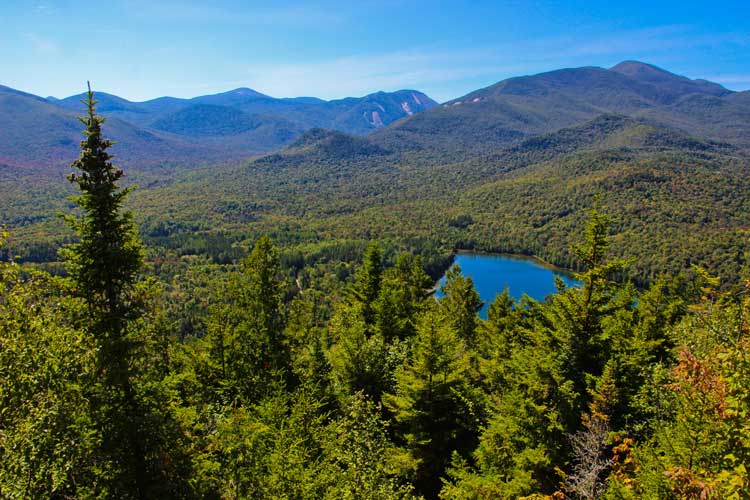
Most Scenic Places in the Adirondacks
Inside are over 2,000 miles of well-maintained nature trails and 46 mountains over 4,000 feet in elevation. That might not sound like much compared to the mountains out West or in the Alps but consider that the base of some mountains here are roughly 300 feet above sea level. The views are commanding.
Best Time to Visit the Adirondacks
The Adirondacks are a four-season resort destination, although many locals feel the need to alert those planning a visit that late May and June is black fly season, when the pesky bugs are out in profusion.
A clear, blue sky during the rest of summer brings to mind the moldy cliché, “God’s country.” The crush of fall colors needs no promotion to lure visitors. Of course, the fact that two Winter Olympics took place here underlines the fact that the area has always been among tops for winter recreation. (Read more at What to See and Do in Lake Placid, NY.)
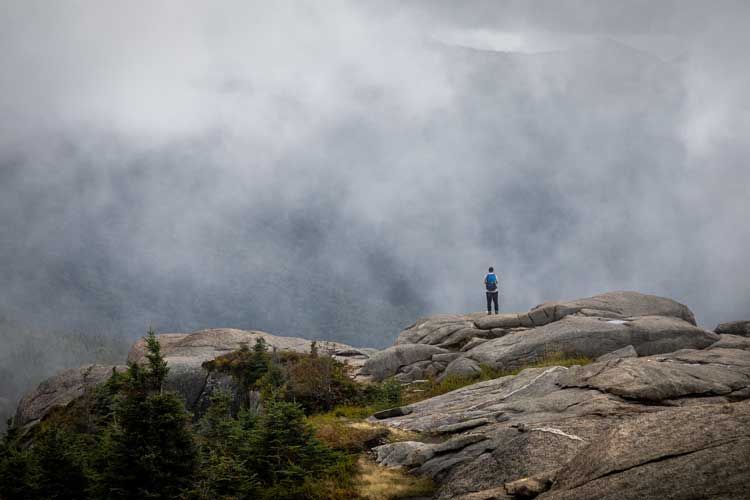
Just about anything that can be done on snow or ice can be done here. One caveat: in the dead of winter, there are usually days where the mercury won’t rise above 20 below zero. That’s the actual temperature, not the wind chill.
It would take multiple visits – and then some — to see everything here. So to those who want a basic understanding of Adirondack life, both natural and historic, here is what one might call an Adirondack sampler.
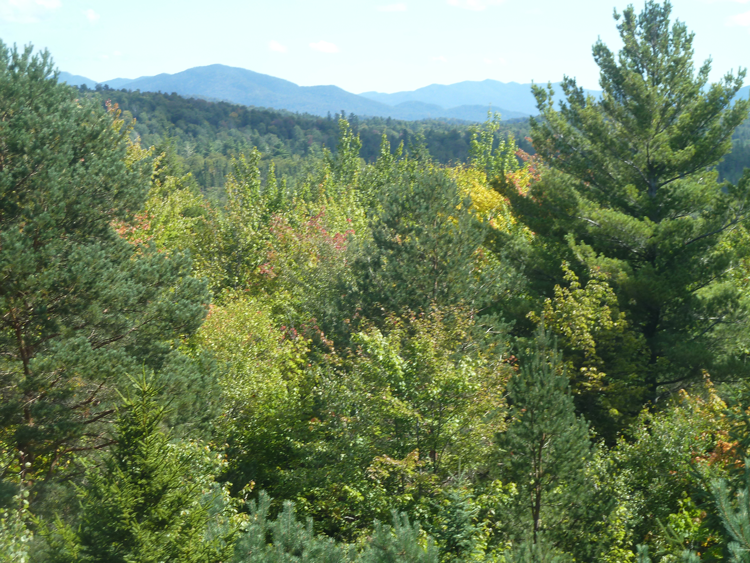
Adirondack Experience, The Museum on Blue Mountain Lake
The best place to comprehend the region is officially called the Adirondack Experience, The Museum on Blue Mountain Lake, which abuts the lake. For years it was simply called the Adirondack Museum, but a major 2017 expansion proved that the humble name is understated.
Try to begin your visit in the 19,000-square-foot interactive exhibition called Life in the Adirondacks. To fully explore it, plan to spend two to three hours.
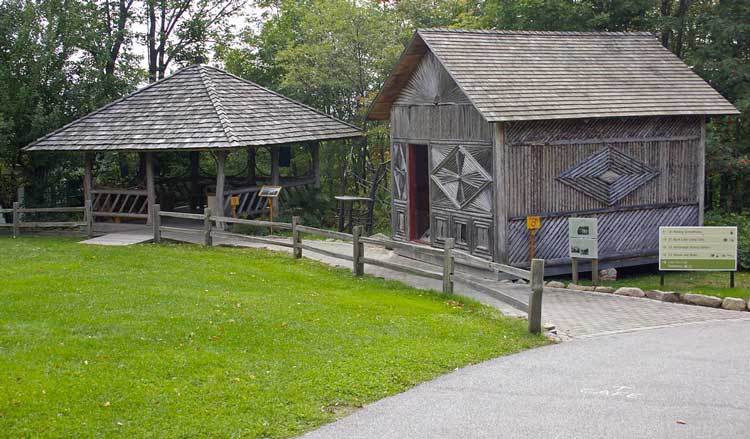
Try your hand at clearing a log jam via virtual reality. Or sit in an iconic Adirondack guideboat, where a docent helps you with the rowing technique. It is different from a standard rowboat and one needs the coordination of a jazz drummer to operate it. It is not easy to get one’s hands correctly coordinated so the oars don’t collide with each other.
For well over a century, city dwellers have left summer urban humidity behind to enjoy the Adirondacks’ fresher air. Modes of transportation to reach the Adirondacks are displayed, from railroad cars to a Concord coach to a big, fat, gas-guzzling, 1976 family station wagon.
Adirondack History
Adirondack stories are also of people, such as Teddy Roosevelt who was descending Mount Marcy when he received word that President McKinley was dying, and pioneering ecologist, author and photographer Anne LaBastille, whose cabin home has been moved here, right down to her guitar hanging on a log wall. But not all who lived and visited here were treated fairly.
There was plenty of bigotry, even here in the great North. There was de facto racial segregation, Jewish children were unwelcome at many area summer camps, and American Indians, whose legacy here dates back 12,000 years, fell victim to annoying stereotypes.
While the Adirondacks today seem synonymous with winter and summer recreation, for years the economy revolved around hardscrabble industries. Aside from logging, the other major business was mining, especially for iron.

Exhibits at The Adirondack Experience
An interactive exhibit allows visitors to place dynamite sticks (artificial ones, that is) in holes in faux rocks, press a plunger on a detonator, and wait for a boom.
The Adirondack Experience explores the human history of the Adirondacks, but The Wild Center in Tupper Lake is the place to go for a look at the region’s natural history from a new perspective – literally. The Wild Center’s Wild Walk offers a viewpoint from treetop level.
A series of elevated boardwalks and swinging bridges allow visitors to see, hear and smell the natural world as birds and other species sense it. Step into a reproduced, actual-size bald eagle’s nest, ten feet wide, to savor a vista of the surrounding hills and mountains. So why is the bald eagles’ nest humongous?
A posted marker explains that bald eagles don’t make their nests all in one season: “Bald eagle pairs reuse nests, adding sticks year after year. One well-studied nest in Ohio was used by pairs of bald eagles for 34 years before the tree finally blew down.”
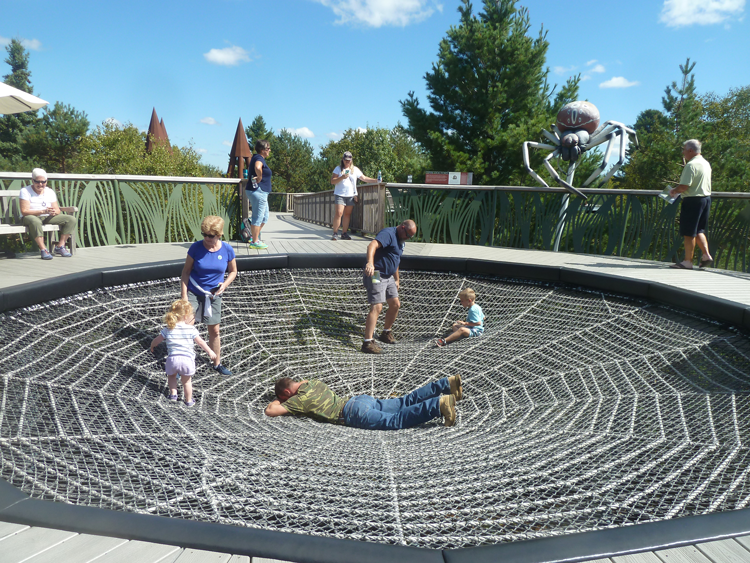
The other eye-catcher here, a spider web on steroids, is an intriguing place to learn about the arachnids as well as a fun spot to crawl in and out of. As for spider trivia, how do spiders clean their webs? They don’t. They simply eat the old ones and make new ones.
The Wild Center
A full visit to The Wild Center entails time both indoors and outdoors. Native Adirondack animals including porcupines, fish, owls and snakes reside here and are the stars of daily presentations called Animal Encounters.
Otters are given their own stage, Otter Falls, where resident otters Squirt, Scarlett and Louie swim and play as part of encounters with the center’s naturalists. It was at one of the otter shows that we learned an otter oddity: otters have a kind of third eyelid that allows them to see underwater.
It’s hard to believe that at one time whales were at home in this region. The remains of an 11,500-year-old beluga were discovered in nearby Vermont in 1849. The weight of glaciers pressed so deep into the earth that ocean water rushed in.
We picked up that tidbit while standing in front of a massive, artificial glacial wall, one of several galleries in The Wild Center that delve into prehistoric times. According to most scientists, even after glaciers retreated tundra continued to cover the Adirondack peaks; it still covers several today.
Shaheen’s Adirondack Inn
Tupper Lake lacks the multitude of lodging one finds in the central Adirondacks. We stayed at Shaheen’s Adirondack Inn, a comfortable family-run motel where guests still lock their rooms with old-fashioned motel keys.
Hoss’s Country Store
Just south of Tupper Lake is the eclectic Hoss’s Country Store, worth a stop just for a look. Hoss’s has everything from fishing gear to books of local interest to a slamming front screen door once common in every neighborhood mom and pop emporium.
In the central Adirondacks are the legendary Adirondack camps, where people with the last name of Vanderbilt, Astor and Carnegie once summered. These camps are rustic estates with guest cabins, some of the most amazing scenery in the eastern United States, and frills to keep any Gilded Age millionaire happy.
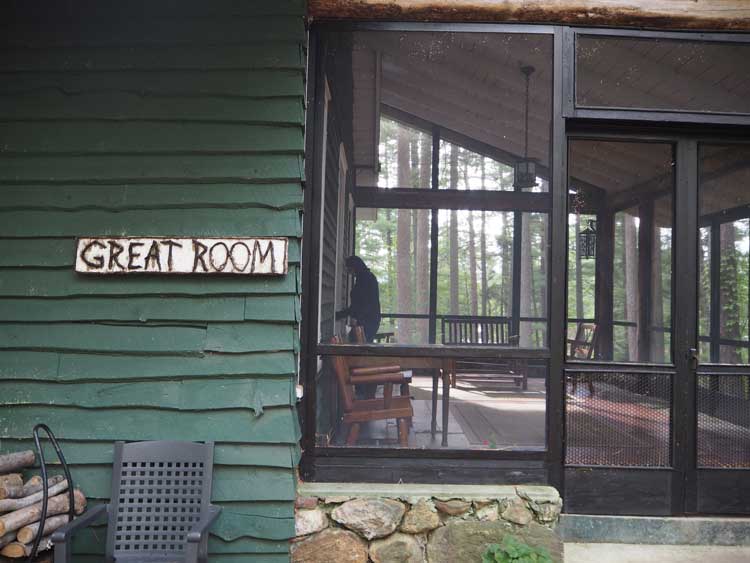
White Pine Camp
Today, few remain. One of those is White Pine Camp in the hamlet of Paul Smith’s. President Calvin Coolidge lived here from July 7 through Sept 18, 1926, making White Pine Camp the Summer White House that year. His cottage can be rented, although the interior looks nothing like it did in Coolidge’s day.
Among the extras at White Pine are walking paths, a Japanese tea house, two boat houses, a tennis tea house and tennis court, and a bowling alley. While bowling today seems to be the favored sport of the Dan Conners of the world, a little more than a century ago it was a preferred amusement of America’s commercial royalty.
Guests can enjoy a game of bowling on two wooden lanes constructed circa 1911, as well as go swimming and boating on Osgood Pond. Guided tours of this quintessential Adirondack camp for those not staying here are given on selected summer days. So at least for a short time, anyone can live like a Rockefeller.
Information: (518) 523-2445 www.AdirondacksUSA.com www.SaranacLake.com www.TupperLake.com
Inspire your next adventure with our articles below:
